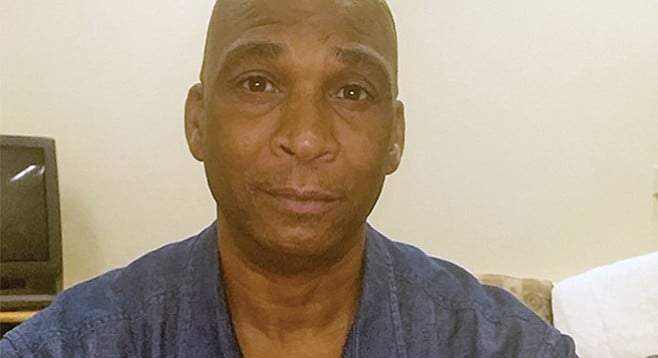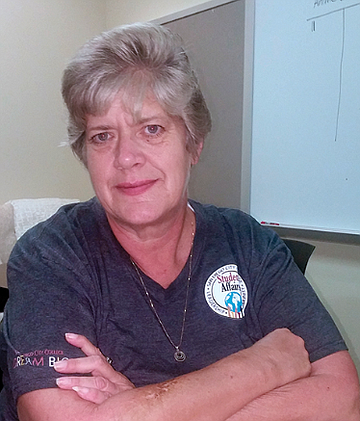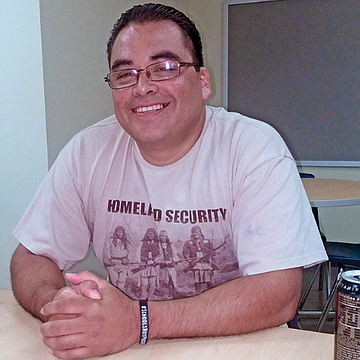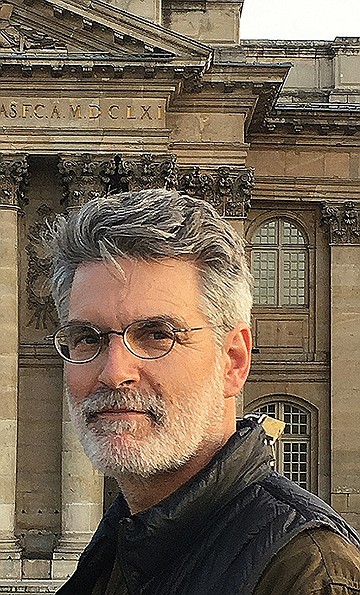 Facebook
Facebook
 X
X
 Instagram
Instagram
 TikTok
TikTok
 Youtube
Youtube

The Urban Scholars Union, established at San Diego City College in 2016, is a student organization helping formerly incarcerated persons create new lives through attending college and earning academic credits and degrees. To jump start that transformation, its members, most of whom were once incarcerated themselves, have been partnering with the California Department of Corrections and Rehabilitation.

So far, not everyone is happy with the relationship. Those who are the least satisfied claim that the correctional department keeps the college group members at arm’s length, decreasing their effectiveness. They want more access to prisoners who are at the point of transitioning out of the criminal justice system. And they believe they have much to offer.
Barbara Lasure, currently vice president of Urban Scholars, tells me she’s seen potential students from the department’s transitional facilities have panic attacks as they come to the college for the first time. “They’re just so anxious about whether they can fit in and succeed here,” she says. “But we take them from one end of the campus to the other, telling them what they have to do and where they have to go.”

Lasure is 53 years old and a sophomore in the alcohol and other drug studies program at the college. She served several prison terms for drug trafficking but is no longer on parole.

I ask Lasure if she experienced suspicion when she visited local prisons. “At Donovan [State Prison], yes,” she says, “though not as much at Las Colinas or other county jails where people are doing their local prison terms.
“Still, there was a time when I had been invited to participate in a fair they had for the women at Las Colinas [Detention and Reentry Facility] and I had just gotten off the paperwork [documenting her criminal record] by a couple of weeks and I hadn’t had any problems over the whole course of my doing time. Yet I was denied access to come into the facility, despite having been invited by the judges to participate in the fair. I was upset and spoke to one of the counselors there. I told her that I’m one of the ones who definitely should have been able to have access, because the transformation that changed my life actually started there. They used to have a treatment program there, and that’s where my life did a big shift, and I’ve never had the opportunity to thank any of the individuals who run that program or been given the chance to talk with any of the women who are trying to do the same thing.”
Patrick Wallace, 50 is the current president of the Urban Scholars Union and a second year student majoring in alcohol and other drug studies at the college. He served 25 years in state prison for violent crime and is still on parole.
Wallace says he struggled with the decision to join the Urban Scholars Program due to fears about the stigma of his history in the minds of fellow students. But he decided he had to face it down. “Nobody on campus has ever confronted me about it, though you can sense what people are feeling sometimes.
I speak to two female students who do not belong to Urban Scholars and have reservations about its presence on campus. “I don’t think City College should try to be a reform school,” one of them tells me. Neither student cared to be identified.
“The Department of Corrections,” says Wallace, “always used to send out the message that they have the answers to the revolving door of recidivism. But today they admit that they need help, that the work they’ve been doing in the past wasn’t effective.... Yet when we say we’re willing to talk to the population at their facilities,” now speaking as though directly to correctional officials, “when we ask to help, you deny it. What we’re saying is that it is very hard for you to reach the people still in custody, because you come from a law enforcement or authoritarian background. You will always be viewed as someone that they feel kept them down. But you can change that mindset if you use us, and we’re showing them that we’ve put down our biases toward law enforcement and [the prison system].
“So the Department of Corrections is not using the people that are out here doing the work, showing by example how to do the right thing, staying out of trouble, and being involved. What message is that sending to someone who is still on the fence, still ambivalent about doing the right thing or going back to the old life, where they might end up coming back into prison.”
The arm’s length the students experience “doesn’t mean that nobody at Corrections wants us there,” says Cesar Garcia who, in addition to his membership in the Urban Scholars student organization, is a paid “peer advocate” in an institutional program at City College called City Scholars. Garcia is 40 years old and served several prison sentences for stealing cars and drug sales. He is currently on probation.
“Some staff,” says Garcia, “understand that we know plenty that can be useful. It’s just the bureaucracy, or what’s called the vetting process. That’s the process we have to go through to go into any of the system’s facilities. It puts us right away into a certain bracket. Boom. ‘Now, with this person, there’s a public safety issue.’ Regardless of whether we make statements about our own lives now and put our own biases away, which is what we do, the paperwork doesn’t show it. We are just asked if we’ve ever been convicted of x, y, or z. It doesn’t ask, ‘When did you change?’ We will never get the free access we want until we’re deemed fit. Who knows when that happens?
“So while we wait for the vetting process to finish, we might lose people who could hear something that would change their life. The issue is the bureaucracy and how it sets us apart.”
Adds Garcia, “After that, it’s a money thing.”
Alan Mobley, director of Project Rebound and professor of public affairs and criminal justice at SDSU, explains by likening Department of Corrections transitional facilities and academic institutions to sandboxes. “The work of each begins and ends at the edges of their sandboxes,” he tells me. Despite California’s $12 billion budget for corrections, “there is no money allocated to pay for helping people once they leave the reentry facilities. It’s during this period that they’re truly, and for the first time in a long time, on their own,” says Mobley.
Project Rebound is the brainchild of John Irwin (1929 - 2010) who, while serving five years in Central California’s Soledad prison during the early 1950s, earned college credit that allowed him to complete a bachelor’s degree from UCLA after his release. In 1967, according to Project Rebound’s website, “Irwin created [it] as a way to matriculate people into San Francisco State University directly from the criminal justice system.” Two years ago, eight other California State University campuses added the program, including SDSU. Shortly thereafter, the program established a “referral network with all community colleges in San Diego County.”
I ask Mobley if there is a connection between the transitional facilities and Proposition 57 that voters approved overwhelmingly in the 2016 elections. The most prominent feature of the law is an early release to parole of non-violent prisoners the correctional system identifies as safe to reenter society.
“The transitional facilities were there first,” Mobley tells me. “But Prop 57 has opened a new stream of clients that pass through the facilities.” Each facility has different regulations, he says, and some of them allow clients to circulate in the outside communities as they investigate job prospects, spend time with their families, or visit college campuses.
Early this year, Prop 57 was condemned for not having defined what constitutes a violent crime, leading to the possibility that some violent ex-cons may now be on the streets. As a result, a ballot initiative was devised for the coming election called The Reducing Crime and Keeping California Safe Act. It had the support of the prison builders, unions for guards, and other law enforcement personnel — what some critics call the “prison industrial complex.” The initiative did not make the ballot.
As Alan Mobley sees it, a turning point has occurred calling for people to “get off their moralizing high horse” and look to “client-centered solutions.


The Urban Scholars Union, established at San Diego City College in 2016, is a student organization helping formerly incarcerated persons create new lives through attending college and earning academic credits and degrees. To jump start that transformation, its members, most of whom were once incarcerated themselves, have been partnering with the California Department of Corrections and Rehabilitation.

So far, not everyone is happy with the relationship. Those who are the least satisfied claim that the correctional department keeps the college group members at arm’s length, decreasing their effectiveness. They want more access to prisoners who are at the point of transitioning out of the criminal justice system. And they believe they have much to offer.
Barbara Lasure, currently vice president of Urban Scholars, tells me she’s seen potential students from the department’s transitional facilities have panic attacks as they come to the college for the first time. “They’re just so anxious about whether they can fit in and succeed here,” she says. “But we take them from one end of the campus to the other, telling them what they have to do and where they have to go.”

Lasure is 53 years old and a sophomore in the alcohol and other drug studies program at the college. She served several prison terms for drug trafficking but is no longer on parole.

I ask Lasure if she experienced suspicion when she visited local prisons. “At Donovan [State Prison], yes,” she says, “though not as much at Las Colinas or other county jails where people are doing their local prison terms.
“Still, there was a time when I had been invited to participate in a fair they had for the women at Las Colinas [Detention and Reentry Facility] and I had just gotten off the paperwork [documenting her criminal record] by a couple of weeks and I hadn’t had any problems over the whole course of my doing time. Yet I was denied access to come into the facility, despite having been invited by the judges to participate in the fair. I was upset and spoke to one of the counselors there. I told her that I’m one of the ones who definitely should have been able to have access, because the transformation that changed my life actually started there. They used to have a treatment program there, and that’s where my life did a big shift, and I’ve never had the opportunity to thank any of the individuals who run that program or been given the chance to talk with any of the women who are trying to do the same thing.”
Patrick Wallace, 50 is the current president of the Urban Scholars Union and a second year student majoring in alcohol and other drug studies at the college. He served 25 years in state prison for violent crime and is still on parole.
Wallace says he struggled with the decision to join the Urban Scholars Program due to fears about the stigma of his history in the minds of fellow students. But he decided he had to face it down. “Nobody on campus has ever confronted me about it, though you can sense what people are feeling sometimes.
I speak to two female students who do not belong to Urban Scholars and have reservations about its presence on campus. “I don’t think City College should try to be a reform school,” one of them tells me. Neither student cared to be identified.
“The Department of Corrections,” says Wallace, “always used to send out the message that they have the answers to the revolving door of recidivism. But today they admit that they need help, that the work they’ve been doing in the past wasn’t effective.... Yet when we say we’re willing to talk to the population at their facilities,” now speaking as though directly to correctional officials, “when we ask to help, you deny it. What we’re saying is that it is very hard for you to reach the people still in custody, because you come from a law enforcement or authoritarian background. You will always be viewed as someone that they feel kept them down. But you can change that mindset if you use us, and we’re showing them that we’ve put down our biases toward law enforcement and [the prison system].
“So the Department of Corrections is not using the people that are out here doing the work, showing by example how to do the right thing, staying out of trouble, and being involved. What message is that sending to someone who is still on the fence, still ambivalent about doing the right thing or going back to the old life, where they might end up coming back into prison.”
The arm’s length the students experience “doesn’t mean that nobody at Corrections wants us there,” says Cesar Garcia who, in addition to his membership in the Urban Scholars student organization, is a paid “peer advocate” in an institutional program at City College called City Scholars. Garcia is 40 years old and served several prison sentences for stealing cars and drug sales. He is currently on probation.
“Some staff,” says Garcia, “understand that we know plenty that can be useful. It’s just the bureaucracy, or what’s called the vetting process. That’s the process we have to go through to go into any of the system’s facilities. It puts us right away into a certain bracket. Boom. ‘Now, with this person, there’s a public safety issue.’ Regardless of whether we make statements about our own lives now and put our own biases away, which is what we do, the paperwork doesn’t show it. We are just asked if we’ve ever been convicted of x, y, or z. It doesn’t ask, ‘When did you change?’ We will never get the free access we want until we’re deemed fit. Who knows when that happens?
“So while we wait for the vetting process to finish, we might lose people who could hear something that would change their life. The issue is the bureaucracy and how it sets us apart.”
Adds Garcia, “After that, it’s a money thing.”
Alan Mobley, director of Project Rebound and professor of public affairs and criminal justice at SDSU, explains by likening Department of Corrections transitional facilities and academic institutions to sandboxes. “The work of each begins and ends at the edges of their sandboxes,” he tells me. Despite California’s $12 billion budget for corrections, “there is no money allocated to pay for helping people once they leave the reentry facilities. It’s during this period that they’re truly, and for the first time in a long time, on their own,” says Mobley.
Project Rebound is the brainchild of John Irwin (1929 - 2010) who, while serving five years in Central California’s Soledad prison during the early 1950s, earned college credit that allowed him to complete a bachelor’s degree from UCLA after his release. In 1967, according to Project Rebound’s website, “Irwin created [it] as a way to matriculate people into San Francisco State University directly from the criminal justice system.” Two years ago, eight other California State University campuses added the program, including SDSU. Shortly thereafter, the program established a “referral network with all community colleges in San Diego County.”
I ask Mobley if there is a connection between the transitional facilities and Proposition 57 that voters approved overwhelmingly in the 2016 elections. The most prominent feature of the law is an early release to parole of non-violent prisoners the correctional system identifies as safe to reenter society.
“The transitional facilities were there first,” Mobley tells me. “But Prop 57 has opened a new stream of clients that pass through the facilities.” Each facility has different regulations, he says, and some of them allow clients to circulate in the outside communities as they investigate job prospects, spend time with their families, or visit college campuses.
Early this year, Prop 57 was condemned for not having defined what constitutes a violent crime, leading to the possibility that some violent ex-cons may now be on the streets. As a result, a ballot initiative was devised for the coming election called The Reducing Crime and Keeping California Safe Act. It had the support of the prison builders, unions for guards, and other law enforcement personnel — what some critics call the “prison industrial complex.” The initiative did not make the ballot.
As Alan Mobley sees it, a turning point has occurred calling for people to “get off their moralizing high horse” and look to “client-centered solutions.
Comments